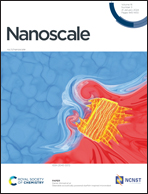A facile, low-cost bimetallic iron–nickel MOF nanozyme-propelled ratiometric fluorescent sensor for highly sensitive and selective uric acid detection and its smartphone application†
Abstract
As a kind of well-known disease biomarker, uric acid (UA) is closely associated with normal metabolism and health. Despite versatile nanozymes facilitating the analysis of UA, most previous works could only generate single-signal outputs with unsatisfactory detection performance. Exploring a novel ratiometric fluorescent UA sensor with high sensitivity, reliability and portable sensing ability based on facile, low-cost nanozymes is still challenging. Herein, we report the first metal–organic-framework (MOF) nanozyme-originated ratiometric fluorescent UA sensor based on Fe3Ni-MOF-NH2 propelled UA/uricase/o-phenylenediamine tandem catalytic reaction. Different from previous reports, the peroxidase-like property and fluorescence of Fe3Ni-MOF-NH2 were simultaneously employed. In the absence of UA, only the MOF's fluorescence at 430 nm (FI430) can be observed, while the addition of UA will initiate UA/uricase catalytic reaction, and the generated H2O2 could oxidize o-phenylenediamine into highly fluorescent 2,3-diaminophenazine (DAP) (emission at 565 nm, FI565) under the catalysis of the MOF nanozyme. Coincidently, MOF's fluorescence can be quenched by DAP via the inner filter effect, resulting in a low FI430 value and high FI565 value, respectively. Therefore, H2O2 and UA can be alternatively detected through monitoring the above contrary fluorescence changes. The limit of detection for UA is 24 nM, which is much lower than those in most previous works, and the lowest among nanozyme-based ratiometric fluorescent UA sensors reported to date. Moreover, the portable sensing of UA via smartphone-based RGB analysis was facilely achieved by virtue of the above nanozyme-propelled tandem catalytic system, and MOF nanozyme-based molecular contrary logic pairs were further implemented accordingly.



 Please wait while we load your content...
Please wait while we load your content...